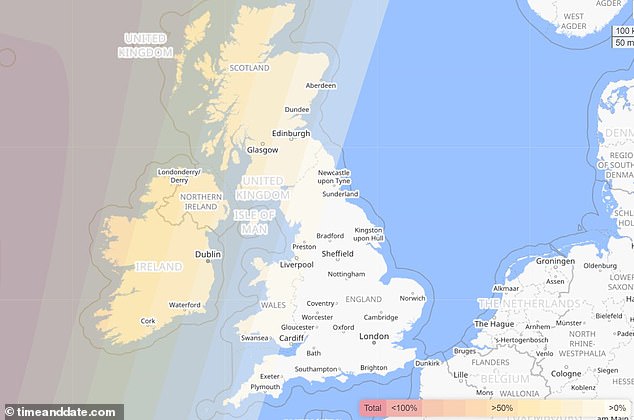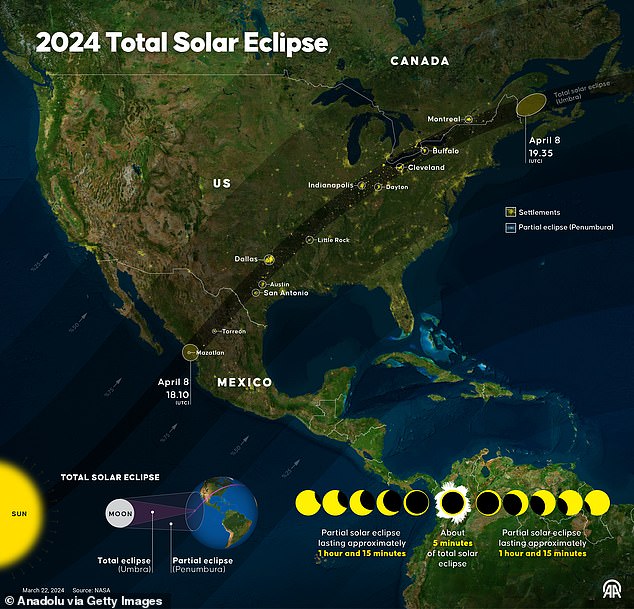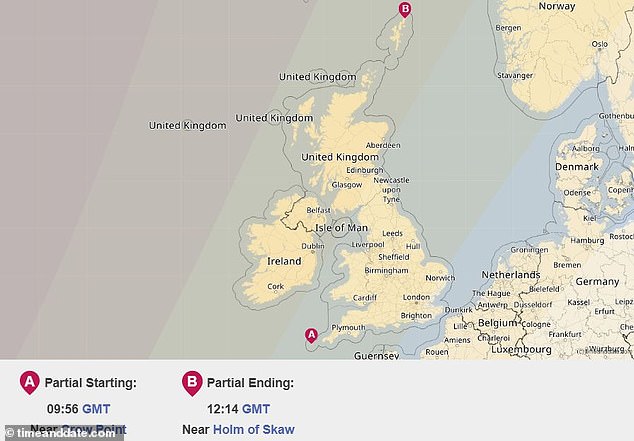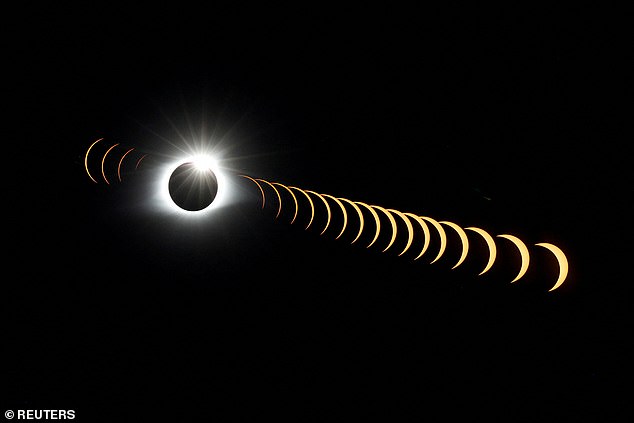Good news for Brits who will miss Monday’s solar eclipse! Scientists reveal when the next one will be visible from Britain – and it won’t be long to wait
On Monday, millions of people in North America will witness the incredible spectacle that is a total solar eclipse.
But there’s still good news for the British, who may be feeling a little left out of all the cosmic splendor.
Not only will a few British cities be able to catch a glimpse of April’s solar eclipse, but another opportunity to see a partial solar eclipse is just around the corner.
Although we will have to wait until 2090 to see the next total solar eclipse over Britain, scientists say a partial solar eclipse will occur in 2025, before a 90 percent solar eclipse in 2026.
Dr. Edward Bloomer, senior astronomer at the Royal Observatory Greenwich, told MailOnline: ‘Throughout history, eclipses have been associated with good or bad luck, but in reality they are a fantastic opportunity to see the mechanisms of the solar system at work.’
On Monday, millions of people in North America will witness the incredible spectacle that is a total solar eclipse
On April 8, a total annular or “ring of fire” eclipse will be visible over much of the US and Mexico.
A solar eclipse occurs when the moon aligns between the Earth and the sun.
When the moon is perfectly aligned, it completely blocks the sun’s light and casts a shadow on the Earth.
To anyone directly in that shadow, it will appear as if the sun is completely obscured by the moon.
Britain is not in this shadow, called the path of totality, so we won’t see a total solar eclipse.
But some people on the western edges of Britain and Ireland may be able to catch a glimpse of a partial solar eclipse just before sunset.
Viewers will see between 44 percent of the sun covered in Belmullet to 11 percent in Glasgow from 7:52 PM BST.
However, because the eclipse will occur so close to sunset over Britain, cities in the west will have a better chance of seeing some eclipse.
This is the second total solar eclipse to occur over the US in just seven years.
One town, Carbondale, Illinois, will have been in the path of both eclipses, earning it the nickname “America’s Eclipse Crossroads.”

As this map shows, some British cities will be able to catch a glimpse of the eclipse this Monday. The more purple shadow areas show where more of the sun will be darkened
This is even more extraordinary considering how rare total solar eclipses are in the first place.
Dr. Kenneth Phillips, science officer at the Natural History Museum, told MailOnline: ‘Eclipses of the sun or moon usually occur a few times a year, but total solar eclipses are very rare.’
The moon does not orbit the Earth in the same plane as the Earth orbits the sun, making perfect alignment quite rare.
Dr. Phillips explains: ‘The Moon’s orbit around the Earth is inclined by just over 5 degrees relative to the Sun, so only when the point where the Moon and Sun’s orbits intersect at the new moon do we get a solar eclipse.’
The main reason the US has been so fortunate to see two eclipses in the past seven years, according to Dr. Phillips, simply has to do with the size of the country.
He says: ‘Solar eclipses can occur anywhere on Earth, no one place is preferred.
‘The area of the US is 10 million square kilometers, that of Britain only 1/4 million square kilometers, so the chance of a total solar eclipse in the US is about 40 times greater than in Britain.’
Hopeful eclipse chasers in Britain will have to wait quite a while to see a total solar eclipse, with the next one not visible until 2090.
However, if you can’t wait until then, there’s good news.
Dr. Bloomer added: “There should be a partial solar eclipse on March 29, 2025 (although coverage is less than 50% even if you go to the Shetland Islands).”
The best place to see next year’s eclipse is Scotland, in cities like Glasgow, where 42 percent of the sun will be covered.

The path of totality (shown) shows where the sun will be completely eclipsed by the moon. Outside this narrow band, people can only see the sun slightly obscured

A partial solar eclipse will be visible from Britain on March 29, 2025. This map shows that the eclipse will be visible across the country, but places in the north of Scotland will get the best view
As you go further south, less of the sun will be covered, but even in London people will be able to see 30 percent of the sun obscured by the eclipse.
The 2025 solar eclipse will start around 10am GMT and end around noon, meaning there will be a good window to view the eclipse above buildings or trees.
And in August 2026, there will be an even better partial solar eclipse over Britain, with more than 95 percent of the sun hidden in some places.
The best views of this eclipse can be found in the westernmost parts of Cornwall, in towns such as Penzance, Porthleven and Truro.
However, there will be good views of the eclipse from all over the country, as London, Birmingham, Bristol, Cardiff and Glasgow will all see 90 percent of the sun eclipsed.

A solar eclipse occurs when the moon aligns between the Earth and the sun. When the moon is perfectly aligned, it completely blocks the sun’s light and casts a shadow on the Earth
Provided there aren’t too many clouds, this is the best chance for a long time to see something approaching a total solar eclipse.
Although there is a chance of a small partial solar eclipse every year until 2030, most of these will only obscure a very small portion of the Sun.
However, if you plan to watch Monday’s eclipse or any other eclipse in the coming years, it is absolutely essential that you use the right equipment.
Dr. Bloomer says, “Don’t look directly at the sun, even for a moment.”
